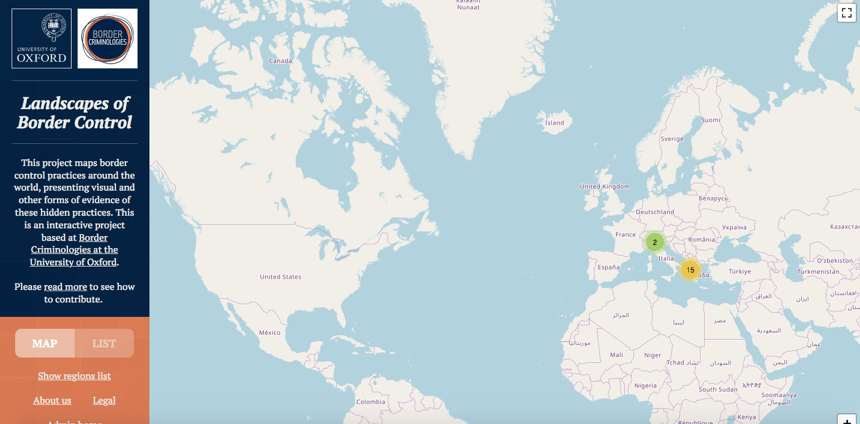The Landscapes of Border Control: Mapping border control and resistance
Posted:
Time to read:
Border Criminologies is pleased to launch our new interactive website, the Landscapes of Border Control. Starting with material gathered from and about Greece and Italy this project aims to visualise what goes on in detention centres in order to increase public understanding about immigration and the treatment of immigrants in detention settings. Eventually, other countries will be added.
Despite the increased media and political attention on Italy and Greece as key sites of European border security, we still know little about everyday life inside detention sites in these two countries. This map, and the stories that accompany it, seek to fill this gap by contextualising and communicating the presence and function of these sites of confinement as well as the lived experiences of those within them. In doing so, this project seeks not only to present the violence of the border control regime but also to illuminate the struggles of those affected by it.
Such a project is particularly important, we believe, in the face of the alarming growth of the detention estate worldwide, and particularly in Italy and Greece. For instance, in Italy a new detention centre has been re-opened in December at Gradisca d’Isonzo, and another one is in the process of being opened in Macomer. Tragically, two deaths have already occurred in 2020, the latest one occurring on Saturday 18 January, when a 20-years old man died in the hospital of Gorizia. Early reports suggest that Vakhtang Enukidze had been seriously injured during an episode of violence within the Gradisca detention centre a few days before. While an investigation is currently underway, early reports from activists reveal considerable police brutality (see here). In response, they have organised a demonstration in front of the centre in solidarity with the detainees inside (see here). This latest tragedy demonstrates, once again, the importance of joint efforts to ensure that what happens in detention is not hidden from scrutiny, that detainees' experiences are heard, and that human rights defenders are given information and support.

Moved by these aims, this countermapping project presents a variety of forms of evidence including videography, photography, original art, oral history, and testimonies from those directly affected. The material disseminated through this platform draws on a large set of data obtained over different time periods and under a range of diverse projects and long-term engagement with civil society organisations. It is specifically designed to offer a platform to civil society organisations, solidarity groups, (ex) detainees and the public to communicate their experiences from detention and
The map shows the locations of facilities where migrants may be detained in both Greece and Italy. Clicking on a node, you can see the name of the centre; click again and you will be directed to the centre’s page where an array of information will be provided including images, video and audio (where applicable), academic work, human rights organisations’ reports, policy briefs and other published material. We hope that in time, the material we provide will be enriched by original contributions from people in the field and those who have survived the centres.
Items can be added easily through the button ‘add information to this location’ found at the bottom of each individual page. An example can be seen here for Ponte Galeria in Rome. Entirely new locations can also be added by filling in information on this page. Items will be screened by Border Criminologies’ members. Information can also be provided in Italian and Greek and will be translated by us.
Contributors will remain anonymous if they wish and they can add either free text, a pdf document, video or audio files.
This is a collaborative project, designed to give organisations and groups already in detention an avenue for publicising their findings and disseminating them to a wider audience which is not limited to their national contexts but reaches out globally. We have received considerable assistance from a range of people and collectives/NGOs in getting it this far. Among these, in Italy, we would like to mention BeFree, ADIF, ASGI, the Migrant Observatory Basilicata, LasciateCIEntrare, CILD, Antigone, Sant’Egidio, A Buon Diritto, the International University College of Turin and the Legal Clinic of Roma Tre on migration and asylum. So, too, we have worked with the Greek Refugee Council and Aitima, among others.
We hope this initiative, which is supported by the ‘Public Engagement with Research Fund,’ at the University of Oxford and the Open Society Foundations, will challenge attempts by the Greek and Italian states to invisibilise and spatially isolate immigrants, while supporting local partners who are engaged in advocacy and strategic litigation, e.g. through factual investigation, research and analysis. We believe that this project can provoke critical witnessing. This map depicts Italy and Greece as they are experienced and shaped by migrants’ presence and their struggles.
Any comments about this post? Get in touch with us! Send us an email, or post a comment here or on Facebook. You can also tweet us.
__________
Share:








